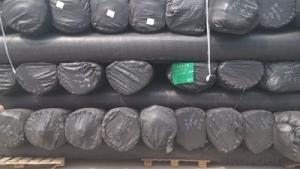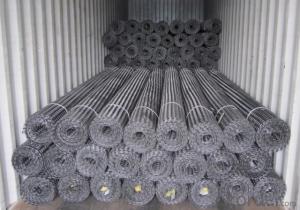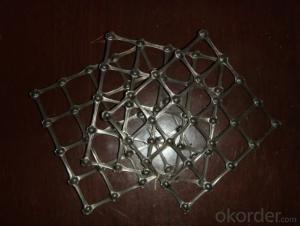HDPE Geomembrane for Environmental Projects water conservancy projects landfill mining canal:
- Loading Port:
- Tianjin
- Payment Terms:
- TT OR LC
- Min Order Qty:
- 88 m²
- Supply Capability:
- 1800000 m²/month
OKorder Service Pledge
OKorder Financial Service
You Might Also Like
Introduction of CNBM
China National Building Materials (Group) Corporation (CNBM) is a state-owned enterprise in charge of administrative affairs in China building materials industry. Established in 1984, CNBM is a large group corporation of building materials with total assets of RMB 25 billion and a total staff of 30,000. Now CNBM owns more than 200 subsidiaries in and abroad the country, including wholly-owned corporations and joint ventures.
FAQ of geosynthetics :
What is geosynthetics ?
Geosynthetics form a perfect erosion control fabric used extremely widely in civil engineering to stabilize and reinforce slopes and soil under or next to roads, railways, dams, water reservoirs etc.. They can be easily applied which minimizes the time of construction, as well as they limit the resources and materials necessary.
What kinds of geosynthetics we have ?
Non-woven geotextile, geogrids, geocells, GCL, Geomembranes, Geonets, Geocomposites etc .
What is the geosynthetics used for ?
Hydraulic
Lagooning and Water Treatment, Ornamental Ponds, Golf Courses
Aquaculture and Desalination,Water Lagoons,Tanks, Reservoirs, Liquid Waste,Floating Cover Solutions, Drainage and Filtration
Environment
Tailing ponds, Leach mining,Landfills,Landfill Capping,Protection against corrosion,Vertical Barriers
Civil Works
Erosion Control,Secondary Containment,Tunnels,Linear and Surface Works,Consolidation of Margins,Soil Reinforcement,Soil Separation.
Building - Parkings,Roofing,Soundproofing
The description of HDPE Geomembrane for Environmental Projects water conservancy projects landfill mining canal
Geomembranes are impermeable geosynthetics that, until recently, were mainly used as canal and pond liners. However, modern technology has broadened liner applications to include landfills, wastewater treatment lagoons, oil and gas exploration (including hydraulic fracturing or "fracking"), aquaculture, irrigation ponds and remediation. In many of these applications, a nonwoven geotextile is used as a cushion to protect the geomembrane. In general, geomembrane liners offer excellent puncture resistance and can withstand a wide range of chemicals and temperatures. They are also highly flexible and conform well to the subgrade.

Specification of HDPE Geomembrane for Environmental Projects water conservancy projects landfill mining canal:
I. Thickness: 0.3mm-3. Omm
2.4m-9m in roll width, the length as client ' s request
Features or Property of HDPE Geomembrane for Environmental Projects water conservancy projects landfill mining canal:
I. Good flexibility
2. For service temperature range: -700C-+1IOoC
3. Corrosion resistance, aging resistance
4. Excellent environmental stress cracking resistance property
5. High tensile strength and elongation
Application of HDPE Geomembrane for Environmental Projects water conservancy projects landfill mining canal:
I. Municipal environmental projects, water conservancy projects
2. Landfill cap(closures), mining heap leach pads
3. Pond liner, canal linings, tank linings, raw water treatment reservoirs, retention ponds
4. Waste water treatment lagoon, secondary containment
Production standard:
I. GB/T17643-2011
2. CJ/T234-2006
3. GRI-GM13
Area |
|
Hydraulic | Lagooning and Water Treatment, Ornamental Ponds, Golf Courses Aquaculture and Desalination Water LagoonsTanks, Reservoirs, Liquid WasteFloating Cover SolutionsDrainage and FiltrationShading Cover Solutions |
Environment | Tailing ponds, Leach mining,Landfills,Landfill Capping,Protection against corrosion,Vertical Barriers |
Civil Works | Erosion Control, Secondary Containment, Tunnels,Linear and Surface Works,Consolidation of Margins,Soil Reinforcement,Soil Separation. |
Building | Parkings,Roofing,Soundproofing building |
- Q:What are the names of geotextiles?
- Geotextile is a kind of new building materials, raw materials are synthetic fiber polyester, polypropylene, acrylic, nylon and other polymers. According to the manufacturing method, it is divided into two types: the nonwoven geotextile and the nonwoven geotextile. General engineering is mainly used in non-woven geotextiles. Geotextile has many functions, such as filtration, filtration, isolation, reinforcement, protection, sealing and so on.
- Q:Can geogrids be used in reinforcement of tunnels and underground excavations?
- Yes, geogrids can be used in the reinforcement of tunnels and underground excavations. Geogrids are often installed to provide additional support and stability to the surrounding soil or rock mass, reducing the risk of collapse or deformation. They can help distribute the applied loads and increase the overall strength of the structure, making them a suitable choice for reinforcing tunnels and underground excavations.
- Q:Can geogrids be used in ground improvement projects?
- Yes, geogrids can be used in ground improvement projects. Geogrids are commonly used to reinforce and stabilize soil, improving its bearing capacity and preventing soil erosion. They are effective in a variety of ground improvement applications such as road construction, retaining walls, and slope stabilization.
- Q:Are geogrids suitable for use in high groundwater conditions?
- Yes, geogrids are suitable for use in high groundwater conditions. Geogrids are commonly used in civil engineering applications, including in areas with high groundwater levels. They are designed to provide soil stabilization and reinforcement, even in challenging conditions such as high water tables. Geogrids have excellent drainage properties and are resistant to water, making them a reliable solution for projects in high groundwater conditions.
- Q:How does a geogrid work?
- A geogrid works by providing reinforcement to soil or other materials. It is typically made of high-strength polymers or fibers arranged in a grid-like pattern. When placed within the soil, the geogrid interlocks with the surrounding particles, creating a stable network. This enhances the tensile strength and overall performance of the soil, preventing excessive movement, erosion, or failure. The geogrid redistributes applied loads, reducing stress concentrations and improving the stability and longevity of structures like retaining walls, roadways, and embankments.
- Q:Are geogrids suitable for use in ground reinforcement for solar farms?
- Yes, geogrids are suitable for use in ground reinforcement for solar farms. Geogrids provide excellent soil stabilization, erosion control, and load-bearing capacity, which are crucial for supporting the heavy equipment and structures in solar farms. Additionally, geogrids can enhance the overall stability and longevity of the ground, ensuring efficient and sustainable operation of solar energy infrastructure.
- Q:Can geogrids be used in reinforcement of underground tunnels and caverns?
- Yes, geogrids can be used in the reinforcement of underground tunnels and caverns. Geogrids are commonly used in geotechnical engineering applications to improve soil stability and provide reinforcement. They can be installed as a reinforcement layer within the tunnel or cavern walls to enhance their structural integrity and prevent potential collapses or deformations. The geogrids act as a reinforcement material, distributing the loads and increasing the overall strength of the underground structures.
- Q:Are geogrids suitable for reinforcing railway subgrades?
- Yes, geogrids are suitable for reinforcing railway subgrades. Geogrids are specifically designed to improve the stability and strength of soil and can effectively distribute loads, reduce settlement, and prevent lateral movement. They are commonly used in railway construction and maintenance projects to enhance the performance of subgrades by providing additional support and increasing load-bearing capacity.
- Q:What are the benefits of using geogrids in construction projects?
- Geogrids offer several benefits in construction projects. Firstly, they provide increased stability and reinforcement to soil structures, enhancing their load-bearing capacity. This can reduce the need for excessive excavation and the use of additional materials, leading to cost savings. Geogrids also prevent soil erosion by distributing forces more evenly, reducing the risk of slope failures or surface damages. Furthermore, they improve the longevity and durability of structures by minimizing settlement and lateral movement. Overall, geogrids are an effective and sustainable solution that improve the performance and efficiency of construction projects.
- Q:What are the design guidelines for geogrid-reinforced structures?
- The design guidelines for geogrid-reinforced structures involve considering factors such as soil properties, design loads, and installation requirements. Some key guidelines include determining the appropriate geogrid material and strength based on the specific site conditions, ensuring proper connection between the geogrid and the surrounding soil or structures, designing for the anticipated loads and settlement, and following recommended installation techniques to ensure the effectiveness of the reinforcement system. Additionally, considering factors such as long-term durability, maintenance requirements, and environmental considerations are also important in designing geogrid-reinforced structures.
1. Manufacturer Overview |
|
|---|---|
| Location | |
| Year Established | |
| Annual Output Value | |
| Main Markets | |
| Company Certifications | |
2. Manufacturer Certificates |
|
|---|---|
| a) Certification Name | |
| Range | |
| Reference | |
| Validity Period | |
3. Manufacturer Capability |
|
|---|---|
| a)Trade Capacity | |
| Nearest Port | |
| Export Percentage | |
| No.of Employees in Trade Department | |
| Language Spoken: | |
| b)Factory Information | |
| Factory Size: | |
| No. of Production Lines | |
| Contract Manufacturing | |
| Product Price Range | |
Send your message to us
HDPE Geomembrane for Environmental Projects water conservancy projects landfill mining canal:
- Loading Port:
- Tianjin
- Payment Terms:
- TT OR LC
- Min Order Qty:
- 88 m²
- Supply Capability:
- 1800000 m²/month
OKorder Service Pledge
OKorder Financial Service
Similar products
New products
Hot products
Related keywords






























